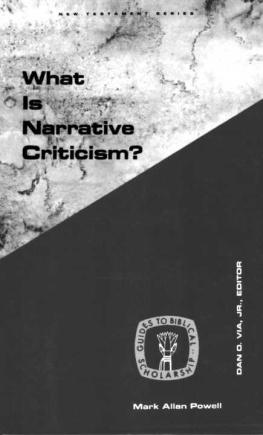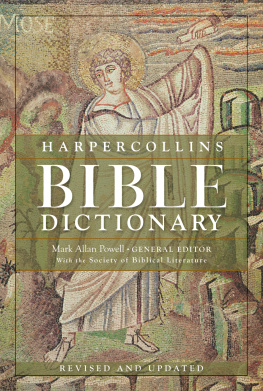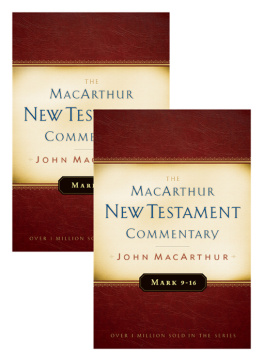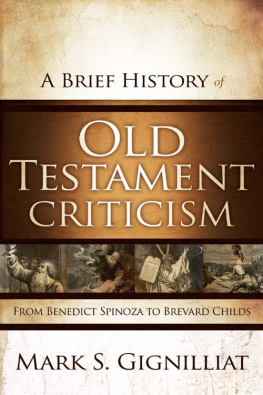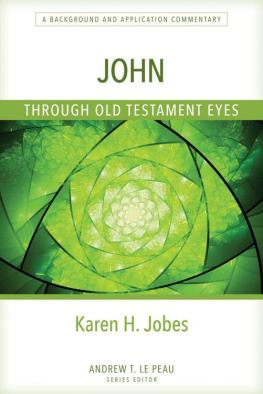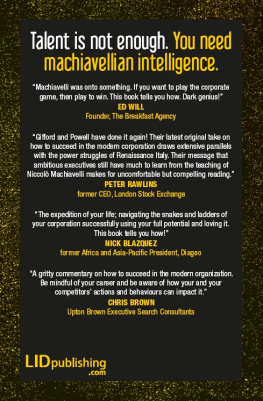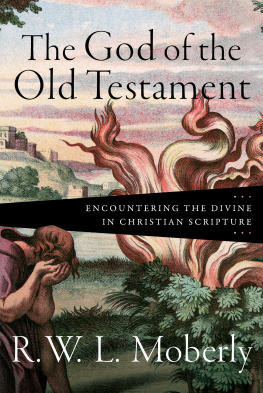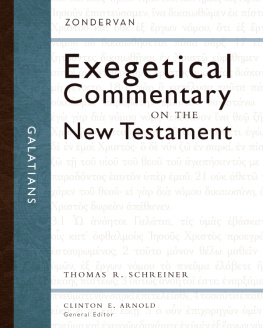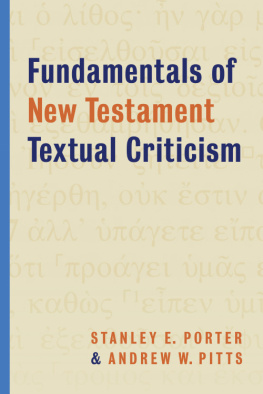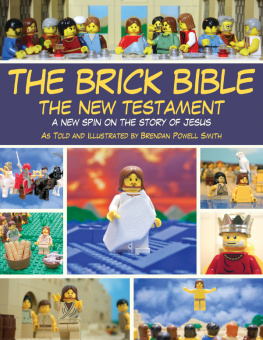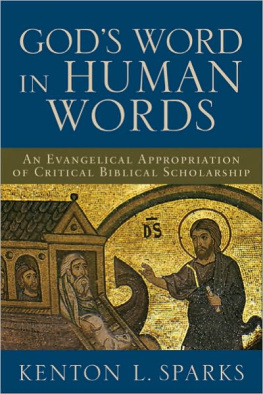Mark Allan Powell - What Is Narrative Criticism? (Guides to Biblical Scholarship New Testament Series)
Here you can read online Mark Allan Powell - What Is Narrative Criticism? (Guides to Biblical Scholarship New Testament Series) full text of the book (entire story) in english for free. Download pdf and epub, get meaning, cover and reviews about this ebook. year: 2008, genre: Religion. Description of the work, (preface) as well as reviews are available. Best literature library LitArk.com created for fans of good reading and offers a wide selection of genres:
Romance novel
Science fiction
Adventure
Detective
Science
History
Home and family
Prose
Art
Politics
Computer
Non-fiction
Religion
Business
Children
Humor
Choose a favorite category and find really read worthwhile books. Enjoy immersion in the world of imagination, feel the emotions of the characters or learn something new for yourself, make an fascinating discovery.
- Book:What Is Narrative Criticism? (Guides to Biblical Scholarship New Testament Series)
- Author:
- Genre:
- Year:2008
- Rating:5 / 5
- Favourites:Add to favourites
- Your mark:
- 100
- 1
- 2
- 3
- 4
- 5
What Is Narrative Criticism? (Guides to Biblical Scholarship New Testament Series): summary, description and annotation
We offer to read an annotation, description, summary or preface (depends on what the author of the book "What Is Narrative Criticism? (Guides to Biblical Scholarship New Testament Series)" wrote himself). If you haven't found the necessary information about the book — write in the comments, we will try to find it.
What Is Narrative Criticism? (Guides to Biblical Scholarship New Testament Series) — read online for free the complete book (whole text) full work
Below is the text of the book, divided by pages. System saving the place of the last page read, allows you to conveniently read the book "What Is Narrative Criticism? (Guides to Biblical Scholarship New Testament Series)" online for free, without having to search again every time where you left off. Put a bookmark, and you can go to the page where you finished reading at any time.
Font size:
Interval:
Bookmark:

Narrative Criticism?
Is
Narrative
Criticism?
by
Mark Allan Powell
For Charlotte
This volume on narrative criticism continues the program of this series, which has been to focus on issues that are relatively broad and formal rather than on one or a few specific texts. That has not meant that practical interpretation has not been used to exemplify the categories under discussion, and so in this volume also the interpretive applications of the critical principles to particular texts are often both relatively lengthy and very illuminating. The previous volumes in the series to which this one bears the closest relationships are Beardslee, Literary Criticism of the New Testament; Petersen, Literary Criticism for New Testament Critics; and Patte, Structural Exegesis for New Testament Critics.
Professor Powell helpfully clarifies the distinction between literary criticism and several modes (source, form, and redaction) of historical criticism and also distinguishes several types of literary criticism (structuralist, rhetorical, reader-response, and narrative). He then goes on to describe, analyze, and illustrate the categories that narrative criticism employs-implied author and reader, narrator, characters, events, settings, and so forth.
DAN 0. VIA
Duke Divinity School
In recent years, I have had numerous occasions to discuss the topic of this book in churches and in classrooms. I wish now to express my appreciation to the students of Trinity Lutheran Seminary and to the pastors and laypersons throughout central Ohio who listened to my views as they were being developed.
I am grateful to Dan O. Via for supporting me in this project and for providing me with needed editorial assistance. In addition, David Bauer, Barbara Jurgensen, Jack Kingsbury, and David Rhoads took time to read my manuscript, in whole or in part, and to make helpful suggestions for its improvement. I also wish to thank Timothy Staveteig and others at Fortress Press who have guided the project through to its completion. Before his untimely death in 1989, John Hollar had occasion to read the entire manuscript and to offer valuable encouragement and advice.
Melissa Curtis, manager of computer services and secretary to the faculty at Trinity Lutheran Seminary, has done most of the work of preparing the manuscript. I continue to be grateful not only for the competence but also for the encouraging optimism and dedication that she brings to every task.
as Story
A scribe who has been trained for the kingdom of heaven, Jesus once said, is like a householder who brings out of his treasure what is new and what is old. The last few years of biblical scholarship have witnessed many such scribes producing many such treasures: some are new, some are old, and some, perhaps, are both at the same time. Narrative criticism is a new approach to the Bible, but it is based on ideas that have been used in the study of other literature for some time.'
In a sense, the Bible has always been studied as literature because, after all, that is what it is-scriptures or writings. The field of biblical criticism knows no methodology that circumvents the act of reading or hearing the text. Nevertheless, the Bible's literary qualities themselves have not been a typical subject for investigation. Rather, the Bible has been read as a record of significant history, a compendium of revealed truth, or a guidebook for daily living. The considerations that caused its various books to become regarded as canonical in the first place were no doubt diverse, but there is no evidence that aesthetic appreciation was among them. Indeed, St. Augustine bemoaned the low literary quality that the biblical writings evince when they are compared to the pagan works of Greece and Rome, a circumstance that he could accept only as indicative of divine humility (Confessions 3.5).
The discovery of literary criticism by biblical scholars, then, is something of an innovation, for it involves a self-conscious reading of the Bible in a way that it has not usually been read. The reasons for this sudden convergence of biblical and literary studies must he understood in terms of recent developments in both fields.'
The dominant mode of biblical studies for more than a century has been the historical-critical method.3 Actually a conglomeration of approaches, this method seeks to reconstruct the life and thought of biblical times through an objective, scientific analysis of biblical material. Source criticism, for example, attempts to delineate the sources that the evangelists used in the composition of their Gospels. Form criticism concentrates on defining the Sitz im Leben (setting in life) that individual units of tradition may have had before they came to he incorporated into the Gospels. Redaction criticism seeks to discern the theologies and intentions of the evangelists themselves by observing the manner in which they edited their sources and arranged the individual units of tradition. These disciplines share a common desire to shed light upon significant periods in the transmission of the Gospels: the period of the historical Jesus, the period of oral tradition in the life of the early church, or the period of the final shaping of the Gospels by the evangelists.
The major limitation of all these approaches, as documented by Hans Frei in 1974, is that they fail to take seriously the narrative character of the Gospels.4 These books are stories about Jesus, not compilations of miscellaneous data concerning him. They are intended to be read from beginning to end, not dissected and examined to determine the relative value of individual passages. In focusing on the documentary status of these books, the historical-critical method attempted to interpret not the stories themselves but the historical circumstances behind them.
The need for a more literary approach to the Gospels had been sounded in 1969 by William A. Beardslee.s Decrying the sharply historical cast of most biblical scholarship, Beardslee suggested that analysis of biblical forms should provide insight not only into the character of the communities that shaped these texts but also into the literary meaning and impact of the texts themselves. Form criticism should include attention to how particular literary forms work, that is, how they invite the reader to participate in the passage under consideration and attempt to evoke a particular response from that reader. The first literary forms in the New Testament to he examined in this way were the parables; some of the most important studies were those of Robert W. Funk, Dan 0. Via, and John D. Crossan.e
Another concern voiced by Beardslee was the need for greater attention to the larger form of Gospel itself. The development of redaction criticism partially met this need by focusing on the role of the evangelists in assembling various traditions into coherent wholes. Whereas form criticism typically regarded the evangelists as mere collectors, redaction criticism insisted on their status as editors who were personally responsible for the finished product. As this discipline matured, appreciation for the role of the evangelists increased still further and they came to be described not only as editors but as authors. Finally, Norman Perrin was led to write, "This means we have to introduce a whole new category into our study... the category of general literary criticism. If the evangelists are authors, then they must be studied as other authors are studied."
Font size:
Interval:
Bookmark:
Similar books «What Is Narrative Criticism? (Guides to Biblical Scholarship New Testament Series)»
Look at similar books to What Is Narrative Criticism? (Guides to Biblical Scholarship New Testament Series). We have selected literature similar in name and meaning in the hope of providing readers with more options to find new, interesting, not yet read works.
Discussion, reviews of the book What Is Narrative Criticism? (Guides to Biblical Scholarship New Testament Series) and just readers' own opinions. Leave your comments, write what you think about the work, its meaning or the main characters. Specify what exactly you liked and what you didn't like, and why you think so.

